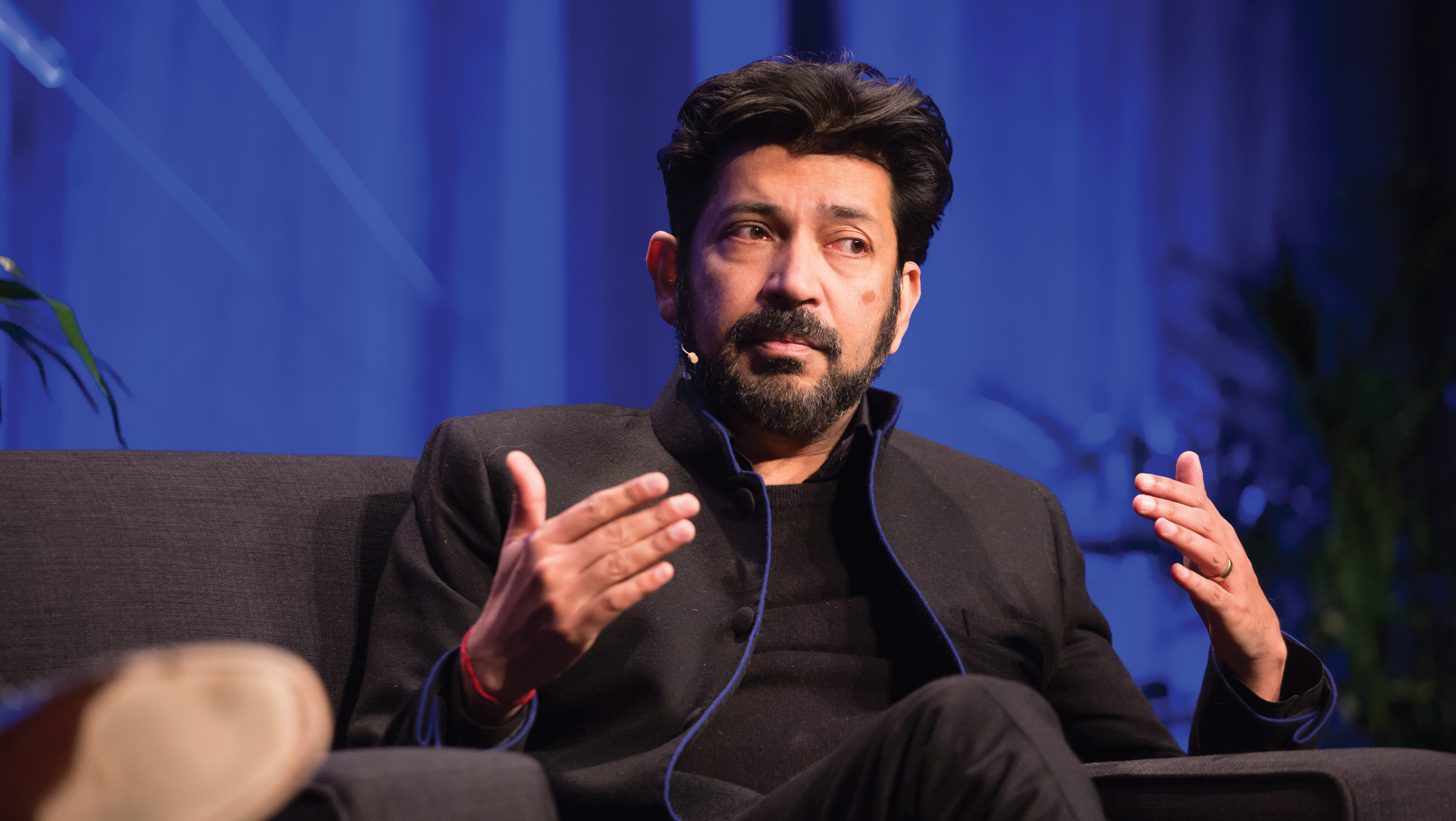
Advancing Scientific Exchange
Neuroscience 2017: Expanding the Boundaries of Neuroscience Across the Globe
From miniature human brains derived from stem cells to a new class of agonists to treat opioid use disorder, the science presented at Neuroscience 2017 demonstrated a breadth of research and innovation taking place around the world.
Neuroscience 2017 brought 30,021 attendees from 80 countries to Washington, D.C., last November, upholding the renown of SfN’s annual meeting as the quintessential venue for international scientific exchange in neuroscience. Attendees presented in scientific sessions, learned from established neuroscientists and leaders in the field, acquired professional skills, and connected with peers both inside and outside of their areas of research.
The annual meeting creates opportunities for researchers to engage in global and interdisciplinary collaboration. As the nature of research evolves to draw on connectivity across disciplines and borders, scientific progress necessitates the sharing of science and collaboration of scientists to solve complex problems in neuroscience. Adapting to this changing landscape, the meeting continues to meet the needs of SfN members and the field more broadly, allowing it to follow novel directions in translational research and clinical applications aimed at improving human health.
CONNECTIONS AMONG SCIENTISTS AND THE PUBLIC
Facilitating scientific exchange among a diverse group of scientists remains a pillar of the Society’s mission. Across the field, organizations are recognizing the importance of continued innovation in basic and translational research. By realizing opportunities for conversation and collaborative research among a diverse group of scientists, SfN helps researchers to establish connections and combine ideas in new ways.

To reinforce the Society’s commitment to supporting the field, SfN Council invested $100,000 for Trainee Professional Development Awards in FY 2018. Combined with other donations, this supported 203 trainees from around the world in attending Neuroscience 2017. The recipients, who represented 119 institutions in 11 countries, presented scientific research at a poster session, met peers and networked with senior scientists, and participated in learning opportunities.
SfN also encouraged early-career scientists in their pursuit of academic and independent research careers by adding two curated itineraries to the 11 topical itineraries, created by SfN’s Program Committee, in the Neuroscience Meeting Planner. These itineraries helped attendees to plan their meeting experience by searching for sessions, workshops, social events, and more to add to their personal itineraries. Created by SfN’s Trainee Advisory Committee, the new itineraries helped undergraduate students as well as graduate students and postdoctoral fellows to find relevant professional development opportunities.
“Methods, questions, and developments happen internationally, so it’s not enough to talk to colleagues from your own country or your own university. You have to view science as an international endeavor. That’s why coming to a meeting, being a member of an international society, is critically important.” — Stefan Treue, Head of the Cognitive Neuroscience Laboratory and Director of the German Primate Center University of Göttingen
Increased communication during the meeting was achieved through display screens located throughout the Walter E. Washington Convention Center that featured attendees’ posts to Twitter and Instagram, tagged with hashtags shared in Neuroscience Extra!, the annual meeting daily digital newsletter. Additionally, attendees could share why they believe global collaboration is important for scientific discovery by responding to a global advocacy poll, the results of which were displayed on a screen that highlighted individual responses and collected them into a world map. An advocacy wheel prompted participants to complete challenges such as tweeting about their advocacy efforts or inviting legislators to their lab.
Acknowledging the personal and public impact of neuroscience, several Neuroscience 2017 sessions demonstrated how storytelling can transform science communication. Two professional development workshops taught attendees valuable storytelling skills for sharing their research with other scientists and the public in a way that elucidates the value of science to society, while a minisymposium featured a panel of speakers who explained the science behind storytelling and shared powerful personal anecdotes. All three sessions were well-attended — reflecting a growing interest in communicating about science through storytelling. A second storytelling minisymposium will take place at Neuroscience 2018.
SCIENTIFICALLY RIGOROUS INNOVATION
The emergent reproducibility crisis demands redoubled attention to maintaining the trust of both scientists and the public. SfN has taken steps to improve transparency and encourage rigorous experimental design, statistical analysis, and reporting.
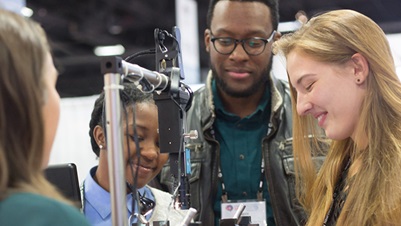
As evidence of its enduring commitment to enhancing scientific rigor while promoting innovation in research, SfN required presenters to summarize efforts to ensure scientific rigor, including sample sizes and replication, blinding, and controls. SfN also asked presenters to transparently report experimental design and analytical methods in their presentation. To assist speakers in demonstrating and understanding the expectations of scientific rigor, SfN provided presenter resources, including templates for poster and dynamic poster presentations, on SfN.org. This year, the Abstracts Rigor Working Group of SfN’s Program Committee developed a template specifically for nanosymposia presentations.
SfN increased the number of dynamic poster presentations from 10 to 15 per session, for a total of 135 at Neuroscience 2017. Dynamic, or digital, posters allow presenters to visualize their data and to connect with the audience by incorporating additional storytelling components into their presentations, such as video, 3D graphics, animations, and other multimedia.
MEDIA

Attracting 304 registered journalists and public information officers and producing 252 original stories and 1,772 news hits and mentions from North America and internationally, Neuroscience 2017 further served to connect scientists and nonscientists across the globe. Articles appeared in news outlets including NPR, The Washington Post, The Hill, Axios, Forbes, and New Scientist, as well as respected scientific publications including Nature, Science magazine, Scientific American, Spectrum, STAT, and Popular Science. Ten press conferences and a Hot Topics book of 100 newsworthy abstracts inspired many of these stories, which covered topics related to health, technology, and medicine, and helped the public to better understand neuroscience discoveries and the value of investment in research.
SfN Journals: Working Together to Advance Neuroscience
SfN’s two peer-reviewed journals, JNeurosci and eNeuro, publish neuroscience research that has an immediate and lasting impact on the field. By providing scientists with the flexibility to report their findings in the way that best suits their work, SfN journals advance the understanding of the brain and the nervous system by adapting scientific journals to science — not the other way around.
JNEUROSCI: UPHOLDING HIGH STANDARDS OF RIGOR
“The peer review process at eNeuro is fast, which is very important nowadays. … The process at eNeuro is also transparent, and communication with the office is easy and fast. We are very happy with how eNeuro handles the overall review process.” — Csaba Cserép, Senior Research Fellow, Institute of Experimental Medicine, Hungarian Academy of Sciences
Published since 1981, JNeurosci continues to receive more citations than any other neuroscience journal. In FY 2018 JNeurosci published more than 900 articles, nearly twice as many as its next largest competitor. The journal has also maintained an acceptance rate of 25 to 35 percent over the past four years. This combination of volume and selectivity distinguishes JNeurosci as a premier venue for research that is shaping the field.
Providing Opportunities for Junior Scientists
JNeurosci recognizes and values the contribution of early-career researchers to the future of neuroscience. Students and postdoctoral fellows are invited to submit a scholarly review of a recently published JNeurosci paper in the form of a Journal Club. In addition to providing readers with commentary and context about contemporary neuroscience research, Journal Clubs offer neuroscientists-in-training an opportunity to assess a current topic in the field and publish in its leading journal.
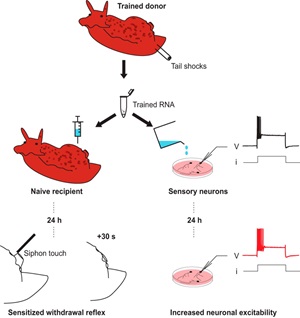
“Educating the next generation of neuroscientists is absolutely critical to me as a value of JNeurosci,” said Editor-in-Chief Marina Picciotto.
JNeurosci also engages early-career scientists in peer review. In January Picciotto announced JNeurosci would begin offering one-on-one peer review training to teach early-career scientists how to fairly and constructively evaluate a manuscript. Interest in the new Reviewer Mentoring Program has exceeded expectations: 27 associate editor mentors and 49 trainees have signed up to participate in the training. Six trainees have completed the program so far, including one who has shared his review of a preprint on bioRxiv. JNeurosci’s Reviewer Mentoring Program pairs associate editors with those who do not have experience as reviewers, reinforcing the value of peer review across the field by introducing early-career scientists to the process by which manuscripts are reviewed. Over time, this program has the potential to share best practices in peer review with multiple generations of neuroscientists.
eNEURO: DRIVING THE FUTURE OF PUBLISHING

SfN Council’s strategic investment in 2014 in the future of scientific publishing enabled the creation of a fully open-access neuroscience journal owned and operated by a nonprofit scientific society. Since launching four years ago, eNeuro has published more than 700 research manuscripts. Traffic to eneuro.org has increased dramatically over the past few years as awareness of the journal continues to grow. Website traffic increased by 93percent in calendar year 2017 to more than 250,000 visits from 195 countries and territories.
Editor-in-Chief Christophe Bernard is leading the journal on an ambitious journey to “improv[e] the way science is done, evaluated, and published.” To that end, eNeuro provides neuroscientists with a place to report data that often goes unpublished. “This is a major issue when people have negative results. They don’t get published, and as a result other groups may redo the experiments again and again,” Bernard said. “We also know that there is a problem with some studies that cannot be reproduced by others, and it’s very important to report them. eNeuro was created to fill this void in the field.”
eNeuro publishes several article types designed to address the reproducibility crisis in science. The journal continues to encourage submissions formerly characterized as “Failure to Replicate” in which an independent group is unable to replicate findings of a previously published, and, in some cases, influential paper. On the other hand, “Confirmation” papers are those in which the authors are able to replicate and extend another group’s work. Together these article types serve the scientific community by providing an additional check on published, peer reviewed research and informing the funding of future work.
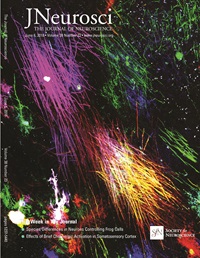
To promote scientific rigor, the journal in March opened submissions for a new article type called “Registered Reports.” This new article type allows authors to preregister their research with the journal before conducting any experiments. If the proposed research question and methodology are accepted by eNeuro’s editorial board, the journal agrees to publish the results upon submission of the full manuscript, provided the authors have adhered to the proposal.
eNeuro is rapidly increasing its content offerings to provide readers with new and innovative ways to keep up and engage with the latest neuroscience. The journal hired its first features editor, Rosalind Carney, who has started writing Research Highlights — articles that place findings of recent eNeuro papers in the context of current scientific knowledge and real world implications.
EXPANDING REACH AND DISCOVERABILITY
Media Relations
With Council’s investment in strategic opportunities, SfN has expanded its capacity to promote research published in the journals beyond academia. Each week the Society prepares and distributes concise summaries of select JNeurosci and eNeuro articles to the press in advance of online publication. These Weekly Journal Highlights communicate the main findings and implications of papers identified by SfN’s Public Education and Communication Committee as suitable for promotion to science reporters. Since launching this initiative in May 2017, SfN journal articles promoted by the Society have earned considerable media coverage.
“As an author it is extremely helpful to receive a Consensus Synthesis Statement. Also, the reviews were fast, polite, and professional.” — Guillaume Sescousse, Senior Postdoctoral Researcher, Donders Institute for Brain, Cognition and Behaviour, Radboud University, Netherlands
For example, SfN coordinated with Penn Medicine in July 2017 to publicize a randomized controlled trial published in JNeurosci of the commercial brain training program Lumosity that found no effect on decision-making or standard cognitive assessments. These efforts generated media coverage in high-profile publications such as The Washington Post, New Scientist, NPR, and Reuters.
Additionally, in May 2018 SfN worked with the University of California, Los Angeles to promote a provocative study, published in eNeuro, challenging the widely accepted view that long-term memory is housed within modified connections among brain cells. Using trained and untrained Aplysia, the researchers reported evidence that memory storage may involve changes in gene expression induced by noncoding RNAs. The New York Times, CNN, Smithsonian, Newsweek, and Scientific American were among the mainstream media outlets to report on the research.
Growing Awareness
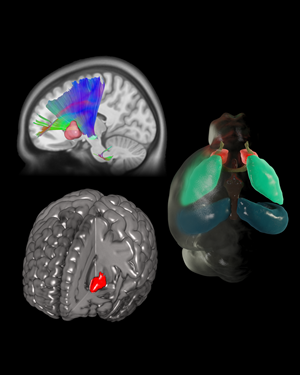
In addition to generating public awareness of research published in JNeurosci and eNeuro, SfN is expanding its scientific audience through a number of tactics. The journals’ official Twitter account, @SfNJournals, gained more than 1,000 new followers in FY 2018 — many of whom are early and mid-career scientists. Impressions and engagement on this channel have grown substantially, demonstrating the value of disseminating scientific content on Twitter.
To expand the reach of eNeuro, SfN sends electronic tables of contents (eTOCs) highlighting recently published articles to SfN members and authors who have published in its journals twice monthly. In FY 2018, the eNeuro eTOCs drove traffic directly to the featured articles, resulting in more than 37,000 sessions and accounting for 11 percent of total traffic to the site. Both journals also offer e-Alerts that allow readers to sign up for email notifications when articles are published, either as “Early Release” articles or in an issue.
“Many of the more interesting scientific questions can’t be answered by one country alone or one lab alone. Collaboration across borders is crucial to progress. I think this is a new trend over the last 20 or 30 years.” — Charles Yokoyama, Director of Research Administration, RIKEN Brain Science Institute, Japan
A recently introduced content recommendation service for scholarly publishing called TrendMD further expands the reach of the science published in JNeurosci and eNeuro. In the lower right hand corner of each article page, readers now see a “We Recommend” widget powered by TrendMD. This tool increases exposure of SfN journal articles by recommending them to readers of more than 2,500 scholarly publications that are a part of the TrendMD network. JNeurosci and eNeuro have a strong presence in Neuroscience Nexus, SfN’s biweekly newsletter sent to its more than 30,000 members around the world. Each issue of Nexus highlights recently published research in both journals as well as papers picked up in the news. Further, selected authors in the journals can prepare a summary of their work to be published on Neuronline, SfN’s professional development and training website. Research summaries are some of the most popular Neuronline content.
JNeurosci and eNeuro strive to recognize that scientists have an ever-expanding universe of journals in which to share their work. As complementary venues for publishing influential research, SfN’s journals are uniquely positioned to move neuroscience forward by reaching the largest community of neuroscientists in the world and helping them to advance in their careers.






